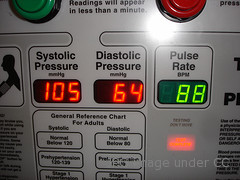It very important to know dangers of low systolic high diastolic blood pressure.
When you go for BP test, two main rates are recorded: diastolic and systolic. These rates are meant to show you the level of your BP. Systolic rate is usually the highest number and it helps to indicate the BP in your arteries during the contraction of the heart.
Diastolic on the other hand, is the lowest number and it is meant to indicate the amount of pressure in your arteries as the heart rests in between contractions. Most blood pressure readings are therefore recorded as low systolic high diastolic. It is of paramount importance for you to understand these readings so that you can continue monitoring your BP all the time.
What is more, blood pressure readings come in millimeters. The easiest way to read BP capacity is 120 mm/Hg / 80 mm/Hg. Adult’s high BP is normally defined as either a systolic and diastolic pressure. For it to fall under systolic it must be 140 mm/Hg and above.
And for the readings to be defined as diastolic they must be around 90 mm/Hg and above. Some people can have high blood pressure with both readings high. Most elderly people have high systolic pressure and a normal diastolic. This disorder is popularly known as secluded systolic hypertension which is also considered being HBP (or hypertension).
The main reason why older adults record very high systolic pressure is because their arteries tend to be less elastic. Their arteries cannot easily expand, which causes their systolic pressure to go up. This condition is rather serious especially when you consider the fact that the same amount of blood is forced to flow through vessels that do not expand.
It is after the blood gets crammed in the arteries that the systolic pressure is pushed up excessively causing high blood pressure. But what is the possible remedy for this problem? Well, interestingly lack of elasticity in arteries does not affect the diastolic level and therefore there is reduced swelling and contraction of blood arteries. This in turn helps in keeping BP at the appropriate levels.
Thus, it is possible for you to find elderly people with normal pressure readings. However, there are some important questions that you always have to ask yourself whenever you are looking for information about this condition. For instance, you need to know what brings about increased diastolic and decreased systolic readings. It is also necessary for you to understand the cause of normal systolic pressure and low diastolic blood pressure readings.
There are so many essential aspects of low systolic high diastolic pressure that you ought to be aware of. For example, you might show these readings if you are suffering from conditions such as heart failure and dehydration.
Normal pressure ranges from 90/60 to 140/90. Systolic pressure indicates the strength of the pressure in your heart during heart beat. So if you find your systolic pressure too high, chances are that you have hypertension disease.

You did not answer my question. What does it mean when your blood pressure is low systolic (114) and elevated diastolic (86)mmHG?